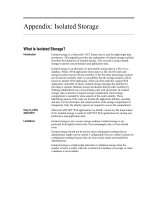Tài liệu Black Box Testing docx
Bạn đang xem bản rút gọn của tài liệu. Xem và tải ngay bản đầy đủ của tài liệu tại đây (47.37 KB, 1 trang )
Black Box Testing is testing without knowledge of the internal workings of the item being
tested. For example, when black box testing is applied to software engineering, the tester
would only know the "legal" inputs and what the expected outputs should be, but not how
the program actually arrives at those outputs. It is because of this that black box testing can
be considered testing with respect to the specifications, no other knowledge of the program
is necessary. For this reason, the tester and the programmer can be independent of one
another, avoiding programmer bias toward his own work. For this testing, test groups are
often used, "Test groups are sometimes called professional idiots...people who are good at
designing incorrect data." 1 Also, do to the nature of black box testing, the test planning
can begin as soon as the specifications are written. The opposite of this would be glass box
testing, where test data are derived from direct examination of the code to be tested. For
glass box testing, the test cases cannot be determined until the code has actually been
written. Both of these testing techniques have advantages and disadvantages, but when
combined, they help to ensure thorough testing of the product.
Advantages of Black Box Testing
• more effective on larger units of code than glass box testing
• tester needs no knowledge of implementation, including specific programming
languages
• tester and programmer are independent of each other
• tests are done from a user's point of view
• will help to expose any ambiguities or inconsistencies in the specifications
• test cases can be designed as soon as the specifications are complete
Disadvantages of Black Box Testing
• only a small number of possible inputs can actually be tested, to test every possible
input stream would take nearly forever
• without clear and concise specifications, test cases are hard to design
• there may be unnecessary repetition of test inputs if the tester is not informed of test
cases the programmer has already tried
• may leave many program paths untested
• cannot be directed toward specific segments of code which may be very complex
(and therefore more error prone)
• most testing related research has been directed toward glass box testing









